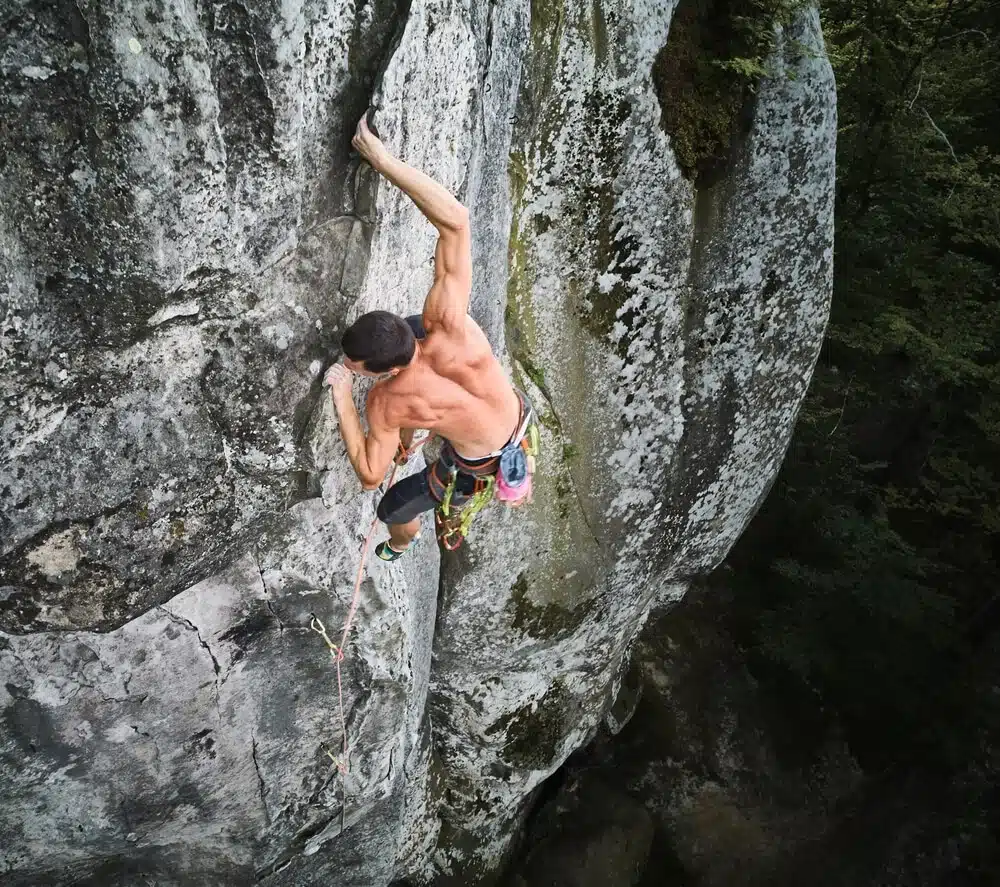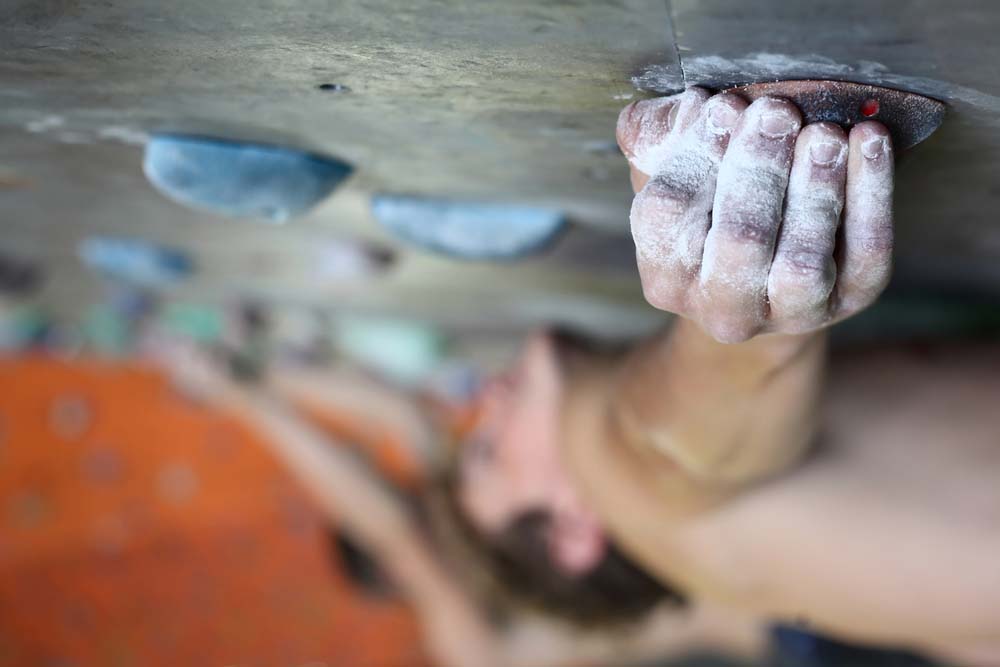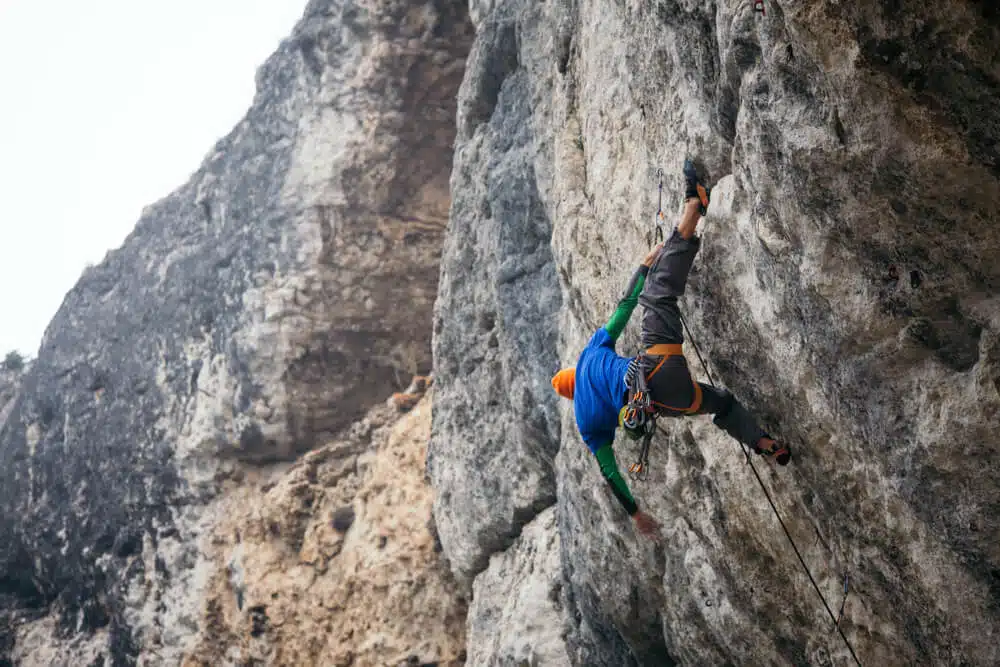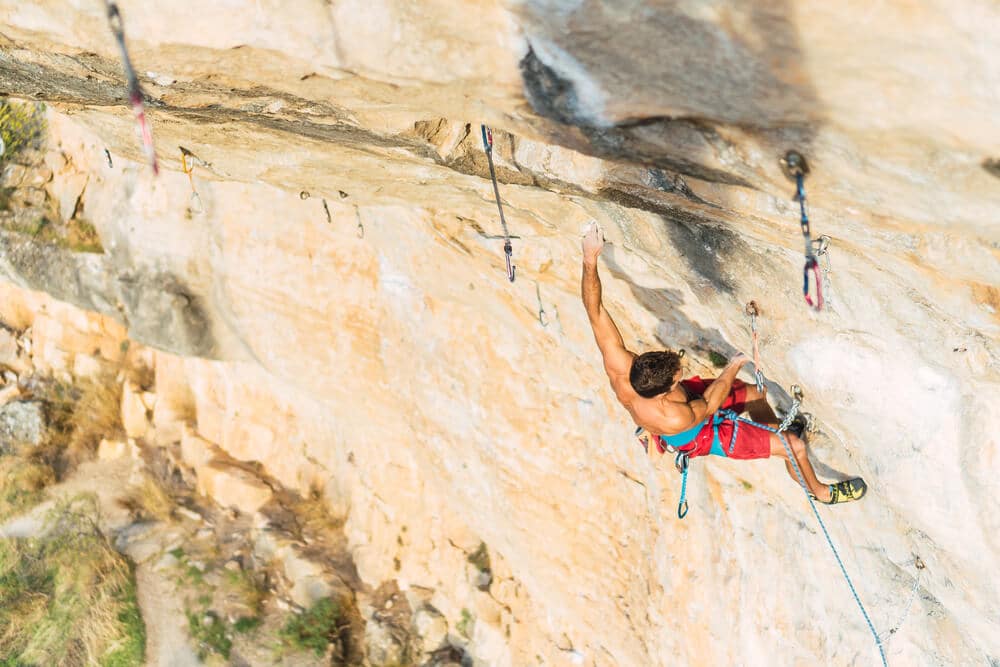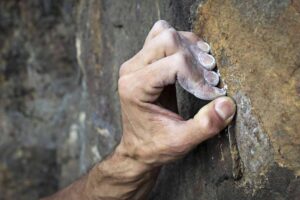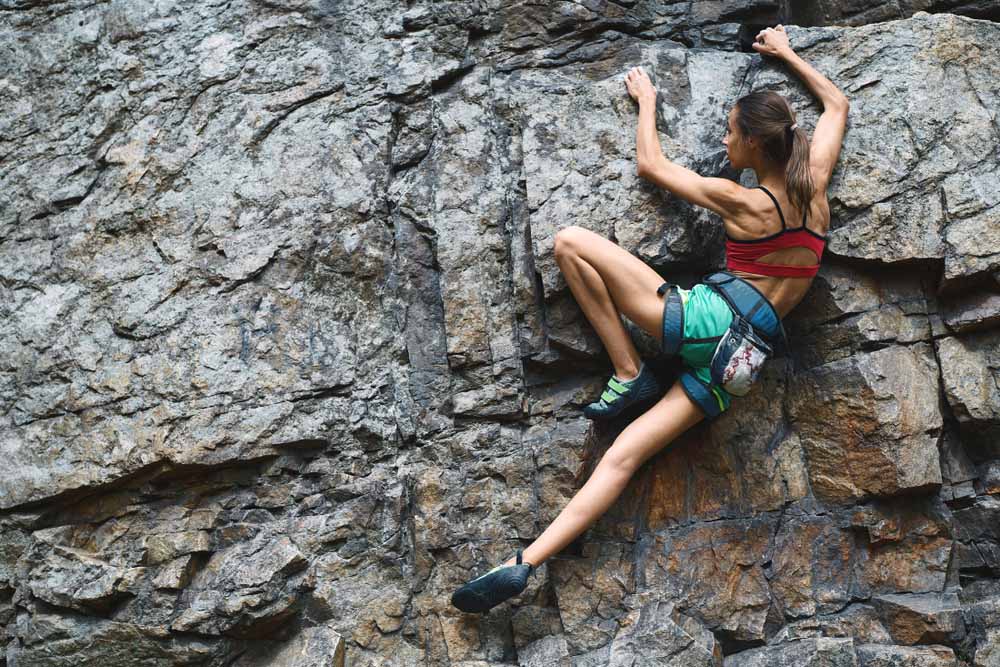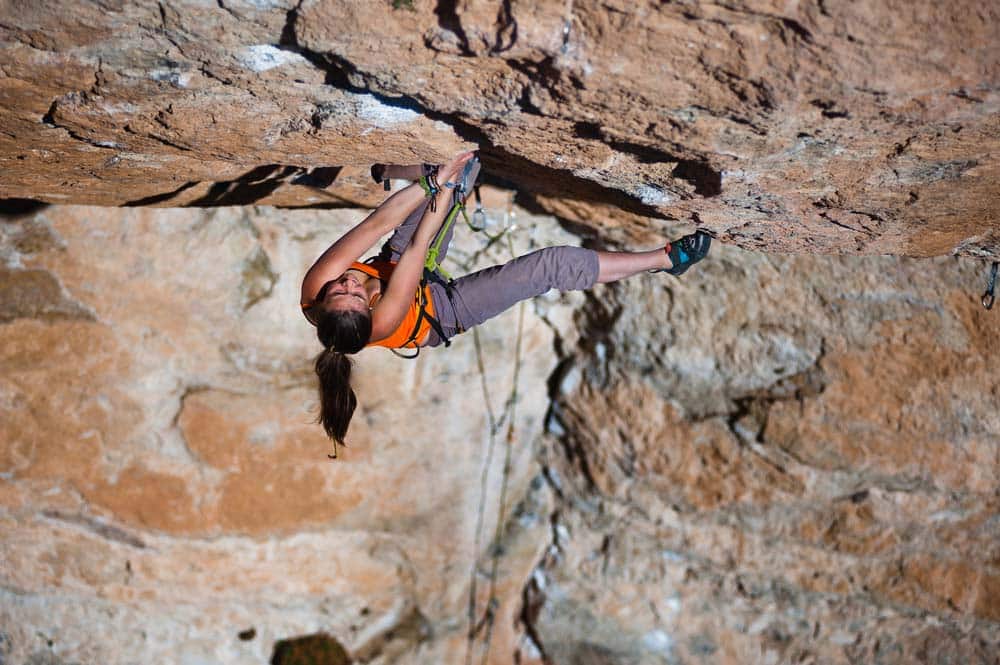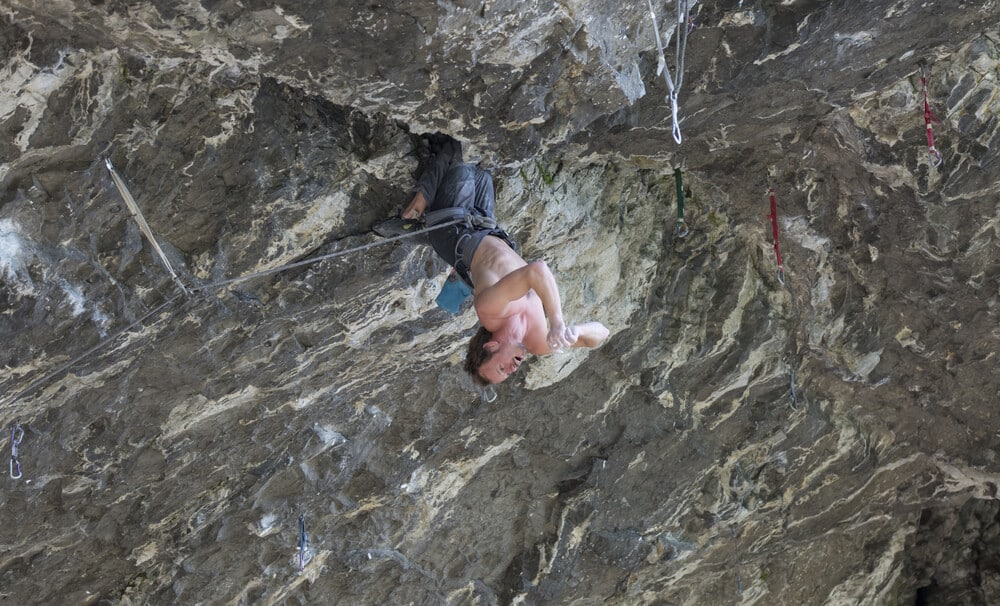From gendarme and pitch to jug to crimp, the sport of climbing is rife with complex jargon, terms that are often indecipherable to beginners. One of these is the “gaston.”
A gaston is a rock climbing movement that involves pulling outward with both hands, creating opposing pressure on two vertical (or near-vertical) planes, such as the two walls of a crack. If you’re having trouble picturing this, imagine trying to open a pair of elevator doors. That’s what a gaston looks and feels like!
What is a Gaston Used For?
The easiest way to think about gastoning comes from their original use, climbing vertical cracks. (They were the move of choice before the technique of jamming was popularized.)
Today, however, you’ll see climbers using the gaston climbing technique any time two viable holds oppose each other inwardly. Any array of holds that allows you to reach in and pull arms straight outwards, create tension on both sides, and hold yourself into the wall… that is territory that’s ripe for a gaston! Whether you’re looking at a pair of facing crimps, slopers, or even monos, you could feasibly use a gaston grip to surmount them.
They’re useful in larger cracks that can’t be easily finger or hand-jammed, and they’re also very useful on indoor boulder sequences, for example, if there are two large volumes with inward opposing faces on a boulder problem.
History of the Gaston in Climbing
The “gaston” is named for French climber Gaston Rébuffat, an alpinist, instructor, and prolific climbing writer. Rébuffat was the first man to climb all six of the great north faces of the Alps (Eiger, Grandes Jorasses, Matterhorn, Cima Grande, Petit Dru, Piz Badile) and was also a key member of the all-star French team that made the first ascent of Annapurna (8,091 m) in 1950.
Their success marked the first ascent of any mountain over 8,000 meters. The team also included other French alpinist legends like Louis Lachenal, Lionel Terray, and Maurice Herzog, the expedition’s leader. (Interested readers should check out Herzog’s book Annapurna [1951] considered a classic of mountaineering literature.)
A photo was reportedly taken of Rébuffat performing a gaston at one point during his career, and the climbing technique was named in his honor after that!
The Gaston Climbing Technique
Perhaps the best way to think about the gaston technique is as the inverse of a side pull. In a side pull, the face of the hold is away from you, and you’re pulling in, toward yourself.
Like a side pull, a gaston is also oriented for sideways force, but instead of pulling in you have to “push” out, using counter pressure to hold your body weight into the wall (or move yourself along it).
As we discussed above, the position is similar to one you’d find yourself in if you were trying to open an elevator door. Your elbows are bent and flared outwards, pointing to the sides, and your fingers are pointed toward you, thumbs oriented downwards (palms facing out).
Gastons often don’t feel as stable as traditional climbing techniques, most of which involve pulling, not pushing. They’re also very intensive on the shoulders and core. But if you practice enough, soon gaston climbing will become second nature.
A gaston isn’t the most commonly found sequence in modern climbing (many cracks that would’ve been gastoned in days past are simply jammed today), but having it in your quiver will certainly improve your versatility and prowess, no matter which rock climbing discipline you pursue.
Using a Climbing Gaston: Tips and Tricks
Understand the Gaston Move
The first step in becoming good at the gaston is understanding why and how it works. In review, a gaston involves using a pair of inward opposing handholds in a way where your elbows are flared out, and you’re pushing outward instead of pulling inward or downward
By nature, one doesn’t typically use this climbing technique to make upward progress, but to traverse laterally, to shift into a body position where face holds become more viable, or to hold oneself into the wall while your feet do the work to move you upward.
Develop Core Strength
A strong core is essential for all forms of climbing, especially on overhanging rock, but it is also quite useful for the gaston, which requires a high degree of body tension. Exercises like planks, sit-ups, and leg raises will help build this strength.
Increase Shoulder and Arm Strength
Gastons rely heavily on arm and shoulder strength. Simple bodyweight exercises like push-ups, pull-ups, and shoulder presses are beneficial, in addition to traditional climbing training. Focus on both strength and endurance.
Work on Flexibility
Being flexible, especially in your shoulders and hips, can make it easier to get into and hold the positions required for a gaston climbing move, which sometimes necessitates twists and bends. Gastons aren’t always perfectly horizontal pull-aparts, like those elevator door scenarios we discussed above! Yoga and dynamic stretching will improve your flexibility.
Improve Footwork
Good footwork is crucial for all climbing techniques, but particularly if you want to use the gaston. The stronger your foot placements, the less weight you’ll be carrying with your gaston, and the easier it’ll be to hold yourself in position.
As mentioned above, gaston grips are also not particularly useful for upward progress in rock climbing. Unless you’re traversing to some degree, you’ll probably be mostly relying on your feet to actually move you up, and the gaston to keep your body weight locked into the wall.
Hone Technique
Spend time practicing the gaston before you put it into play on real rock. You can do this at a rock climbing gym with bouldering problems incorporating a gaston (there should be a few in almost any gym). Pay attention to your body movement, counter pressure, and how you’re applying force.
Other Climbing Techniques You Should Know
Lets discuss a few additional rock climbing techniques that you should know and learn, along with the gaston.
Crimps
Crimps are small holds gripped with the fingertips. This technique requires significant finger strength and precise positioning to maintain grip without straining the fingers excessively.
Sidepulls
A sidepull is grasped with a sideways pull toward the body. It’s often used in situations where vertical holds are not available. Effective use of sidepulls involves a combination of arm strength and body positioning to maintain balance and leverage.
Jams
Jams involve wedging a body part (like the hand, foot, finger, or arm) into a crack and then applying pressure to create friction. This technique is essential in crack climbing. It requires practice to learn how to apply enough pressure to “lock” in.
Heel and Toe Hooks
Heel hooking involves using the heel to secure a hold, often behind a protrusion or over a lip. This technique can be crucial for taking weight off the arms or reaching far holds. Similarly, toe hooks involve hooking the toe around a hold. This technique is useful for maintaining body position on overhangs or for making dynamic moves. Hooking requires strong core muscles and precise footwork, as well as ankle flexibility to hook and hold effectively.
Slopers
Slopers are rounded holds with little to grip onto, requiring climbers to rely on open-hand strength and body positioning. Successful use of slopers involves applying even pressure across the hold and using body momentum to maintain balance and control.
Underclings
Underclings are holds that are gripped from beneath, with the palm facing upwards. This technique requires substantial shoulder and bicep strength, as climbers must pull upwards while pushing with their feet to maintain tension. Proper body positioning is crucial to effectively utilize underclings, especially in maintaining balance and leverage.
Monos
Monos involve gripping a hold with only one finger, usually the index or middle finger. This advanced climbing technique demands extreme finger strength and tendon durability. It requires precise body control to avoid injury. (This author is currently recovering from a tendon injury caused by a move off of a mono.)
Mantling
Mantling involves using upper body strength to press down on a hold or ledge, similar to pushing up to get yourself out of a swimming pool. This technique is often used to transition from a hanging position to standing on a ledge or hold.
Flagging
Flagging is when a climber stretches one leg out to the side to counterbalance their weight. It’s useful in situations where body positioning is crucial for maintaining balance.
Dyno
A dynamic move (dyno) involves jumping or lunging from one hold to another. It’s used when holds are too far apart to reach by stretching.
Layback
Laybacking (or liebacking) is a technique where climbers position their bodies in a way that they can push with their feet while pulling with their hands on opposing holds. It’s often used in crack climbing and on aretes.
Kneebar
A kneebar is a rest move where the climber wedges their knee between two surfaces, using the tension to take the weight off their arms.
Stemming
Stemming involves using opposition between two surfaces to hold the climber’s weight. Stemming is often used in chimneys or corners.


